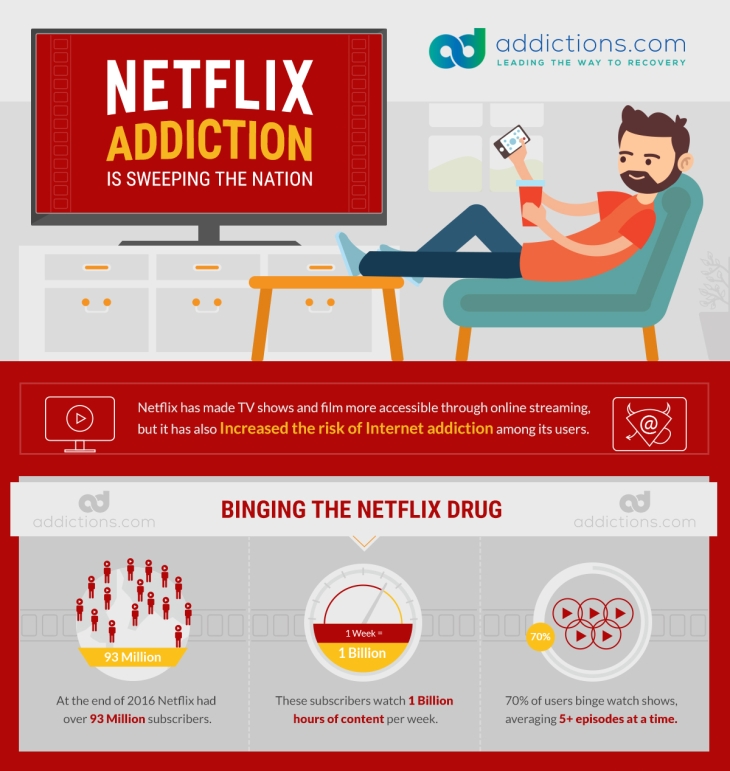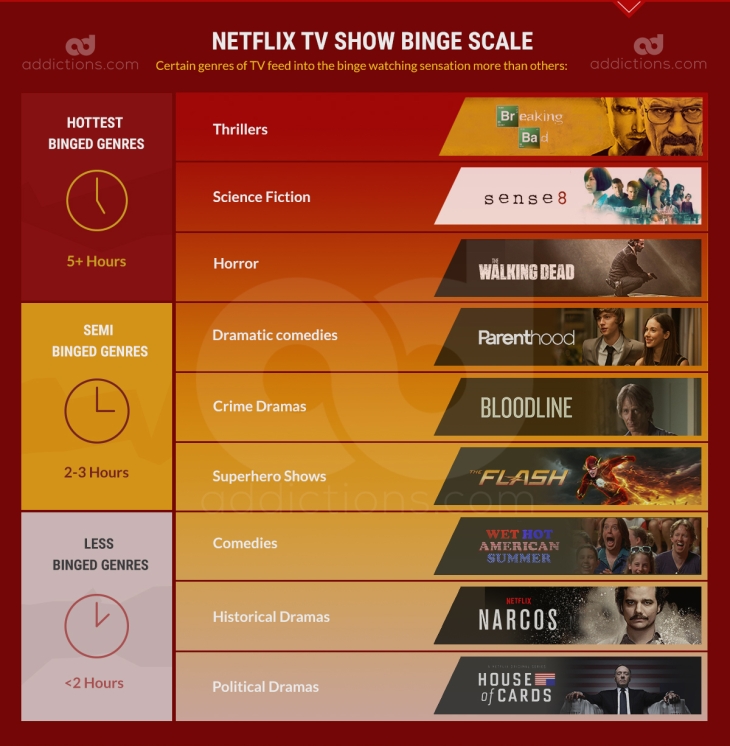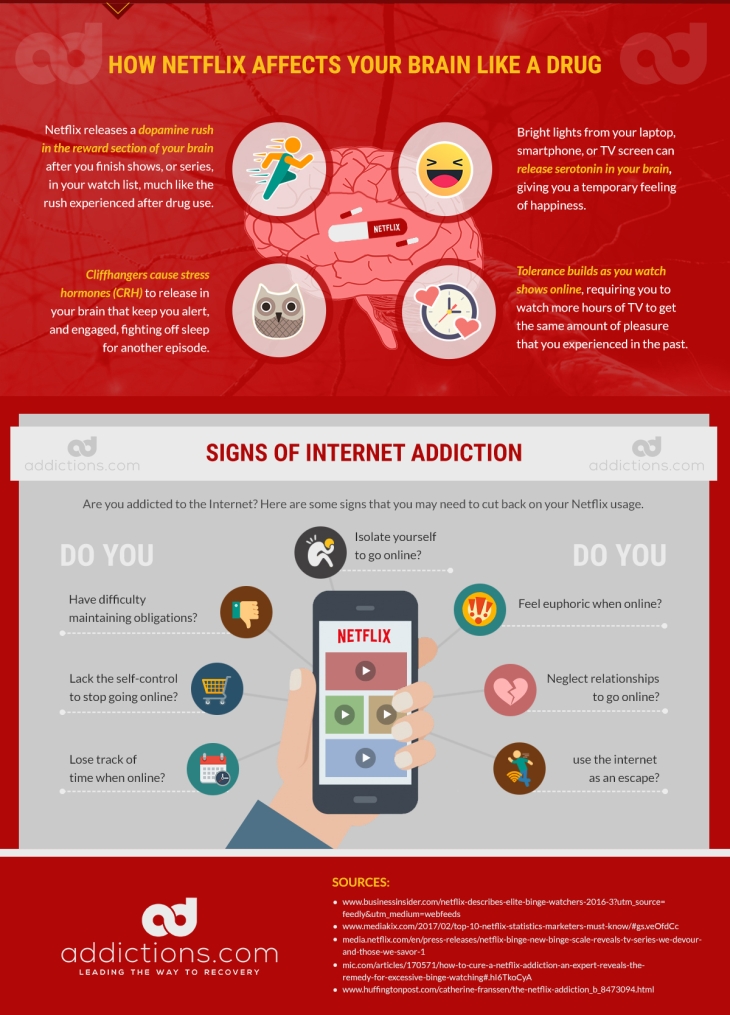Internet addiction has become a widespread problem in the United States today, and Netflix addiction is a common subset of that problem. Internet addiction is a behavioral addiction, like compulsive gambling, and can result in behaviors, such as binging, that are like those found in substance abuse disorders. If you’re not careful, Internet and Netflix addiction can negatively impact your mental and physical health.
Studies show that a binge is a serious, whether it’s on food, alcohol, or entertainment—all each binge has negative consequences; it’s only a matter of degree.
Netflix Addiction in the United States
As of 2016, Netflix had more than 93 million members in over 190 different countries, with 47% of those members residing in the United States. A recent survey of 2,200 Americans found that 70% of respondents reported binge-watching an average of over five episodes in one sitting. Among millennial respondents, 35% binge watch this way every week. With the convenience of having a multitude of TV shows a few clicks away, some Netflix addicts binge every day. In fact, there is a small minority of Netflix users who will start a Netflix series as soon as it is released at midnight, then keep watching continuously until they finish.
How Netflix Addiction is Like Drug Addiction
A large component of any addiction is dopamine. Dopamine is the neurotransmitter that the human brain uses to reinforce natural, life-sustaining behaviors such as eating and having sex. By rewarding us with dopamine, we get a surge of pleasure and contentment, which trains us to repeat the behavior, thereby supporting the survival of the species.
But it isn’t a foolproof system. Certain substances, such as drugs and alcohol, and certain behaviors, such as gambling or binge watching on Netflix, will also release a surge of dopamine, thereby reinforcing the behavior, even if it isn’t particularly healthy. Although the amount of dopamine released by watching episodes of Sherlock all day is not the same as the amount released by a day-long drug binge, it is still enough to train you to repeat the behavior.
Binge-watching also releases serotonin, a neurotransmitter associated with happiness and satisfaction. The sense of accomplishment we get from finishing another episode or season of a show triggers a combination of serotonin and dopamine that is very rewarding, and much easier to obtain through watching Netflix than through longer-term goals like planting a garden or getting a degree. The release of neurotransmitters trains us to watch more, which rewards us with more neurotransmitters, which gets us caught in a loop of binging that can be difficult to remove yourself from.
What makes it even worse is that there are other factors reinforcing the binge behavior loop. For one thing, watching Netflix messes with our time management skills. The human brain processes time best when it is broken down into smaller, even segments, like 30 or 60 minutes. Most shows on Netflix are 20ish or 40ish minutes long. If we tell ourselves we are only going to spend one hour watching before getting back to work, we are going to be partway through an episode when our time’s up—and very few people can resist watching “just a little bit longer” to get to the end of a show.
That’s where the content of the show itself comes in. Television creators have known for decades that a cliff-hanger is a good way to keep viewers interested. Cliff-hangers release fight or flight stress hormones that keep us alert and energetic. Netflix capitalizes on this effect in a far more dramatic way than any network could in a regular season of old-fashioned programming, by not only ending seasons with cliff-hangers, but by ending individual episodes in the middle of a dramatic, unresolved moment. Our bodies push us to keep going onto the next installment because the show has hacked into our instinctive survival mechanisms.
In addition, light itself can stimulate feelings of pleasure and alertness, so while the Netflix content is working on your brain, the light from your viewing screen of choice is working on your body. This is especially problematic at night, when a boost of serotonin from both enjoyment and from the light itself will make you feel both happy and wide awake, disrupting your natural sleep cycle, which requires darkness to transition into making melatonin for sleep.
All of these factors combine to create bad habits in most people, and in others, a pattern of compulsive behavior that persists despite negative consequences. This pattern is the definition of addiction, whether your drug of choice is cocaine or Netflix.
How Netflix Content Gets More Addictive
Another way Netflix helps its content become tempting for everyone and more addictive for individuals with internet addiction is by releasing entire seasons of television shows all at once, like presenting a binge eater with a case of their favorite candy bar, or sitting a compulsive gambler down at a blackjack table in the middle of a casino. They also make it even easier to roll into watching the next episode by using autoplay, which will automatically start the next episode within seconds of the last one ending. This enables Netflix addiction by making sure viewers don’t even have to actively select the option of watching another episode, they can just passively accept the one that is already being played for them.
Since shows with cliff-hangers are inherently addictive, it should be no surprise that thrillers, like The Fall and Breaking Bad, were found to be one of the most addictive genres of content in a recent analysis of Netflix viewing data. Horror series like American Horror Story and The Walking Dead were also shown to be difficult for viewers to resist watching another, then another, then another, as were exciting, immersive Sci-fi shows like Heroes and Orphan Black. The intense stimulation and compelling, overarching storylines found in these shows set us up to keep watching like we are chasing an important goal—and to our brains, which have been wired to need to know what happens next, we are.
Signs of Netflix Addiction
The signs of Netflix addiction resemble those of internet addiction. Here are some signs you or someone you care about may be addicted to Netflix:
- Watching more content than you intend to
- Feeling unable to stop watching even when you know you should
- Building up a tolerance, so that it takes increasingly longer to get the same satisfaction you used to get from an hour or two of watching
- Continuing to binge watch despite negative consequences such as:
- Sleep deprivation
- Isolation from family and friends
- Neglected self-care
- Neglected appearance
- Lack of physical activity
- Poor nutrition
- Declining performance at school or work
- Feelings of preoccupation or obsession with Netflix content and viewing
- Trying and failing to quit or reduce Netflix viewing habits
- Missing out on important opportunities and jeopardizing relationships or jobs due to viewing habits
- Using Netflix to escape from problems, avoid conflict, or self-medicate emotions
- Lying to loved ones to conceal how much time you actually spend watching
Side Effects of Binge Watching Netflix
Recent studies have found that people who frequently binge watch Netflix also experience higher rates of anxiety, loneliness, depression, and problems with self-regulation. Whether Netflix usage leads to these problems, or these kinds of problems lead to Netflix addiction, is unknown. What is known is that addictive behaviors can only temporary mask emotional problems, and that in the bigger picture, addictive behaviors tend to make these problems worse.
There are also physical consequences to binge watching. A study published in the Journal of the American Heart Association found that adults who consume over three hours of television a day double their risk of premature death. Even if you regularly exercise, sitting for hours at a time greatly amplifies your risk of developing health problems such as heart disease, diabetes and cancer. In addition, sustained viewing promotes mindless over-eating of processed foods, which take less preparation and therefore cause less interruption.
What can you do to treat Netflix addiction?
1. Self-help options
If you can handle it, one of the best ways to break a Netflix addiction is to quit cold turkey, so your brain and body can reset themselves without binge-viewing overload messing with you. You could also wean yourself off Netflix slowly, by setting timers to limit how long you watch, or installing technology that will cut you off at a certain time whether you like it or not.
Another helpful approach is to change up your routine. If you’re accustomed to coming home from work and switching on Netflix the moment you walk in the door, try distracting yourself with a different activity, like listening to music, calling a friend, or taking a walk. Changing things up can greatly reduce the compulsive aspect of Netflix addiction, so that it starts to lose its hold on you.
But first, you are likely to experience physical withdrawal symptoms, much like an alcoholic giving up drinking. Some of these symptoms may include fatigue, anxiety, sadness, irritability and difficulty sleeping. In addition, any emotions—like anger—or mental health issues—like depression—that you were self-medicating with Netflix binges will resurface, possibly worse than before. Keep yourself motivated by remembering that eventually your brain and body will normalize, and you’ll feel better than you have for a very long time.
Because binge-watching is a solitary activity for most people, it can be isolating, amplifying feelings of loneliness that can be soothed by Netflix, then return whenever the screen goes dark. A therapeutic way to cut down on your viewing while also improving mental health and connections with others is to get into a show with friends or family. Make sure to take regular breaks away from the show to talk about it as a group, instead of trying to devour the series as fast as you can.
You may want to own up to your addiction to a loved one and enlist their help in holding you accountable for giving up or reducing the time you spend binge watching. Discovering new hobbies and activities is another a great way to both treat Netflix addiction and boost your overall levels of contentment. Make sure they’re healthy pastimes, like a form of creative expression or physical exercise, and you may be able to safely transfer your obsession to something that will enrich your life instead of damage it.
2. Professional Treatment
For individuals who feel powerless to control their Netflix addiction, and are experiencing profound disruptions in their health and wellbeing, a residential treatment program that specializes in behavioral addictions may be advisable. Not only do these programs provide many useful interventions like counseling and Cognitive Behavioral Therapy, just the simple act of experiencing a few weeks to a few months without screens, and with plenty of quality sleep, exercise, and good, nutritious food, can be enormously healing.
Outpatient treatment is also useful. Sessions with counselors and professional addiction therapists can be invaluable to the process of uncovering and treating the underlying mental and emotional issues that drove you to escape into Netflix in the first place. Commonplace problems that make you more vulnerable to internet addiction are depression, high stress, unresolved grief, loss, or trauma; and poor social skills. Counseling can help you work on these and any other issues until you are strong enough to no longer feel the need to escape your life.
3. Give it Time
Whichever way you approach your Netflix addiction, make sure to remain patient and give yourself time to recover. Overcoming a behavioral addiction not only requires you to restructure your life to avoid compulsive behaviors and promote healthier activities; it also requires your body and brain to heal and reset to a more natural state of being.
Keep strong knowing that withdrawal symptoms will pass, new habits will be formed, and you will break the cycle of addiction. Meanwhile, as you check back into the outside world, you will be in a better place to discover and appreciate the many pleasures of life that don’t involve screen time.



